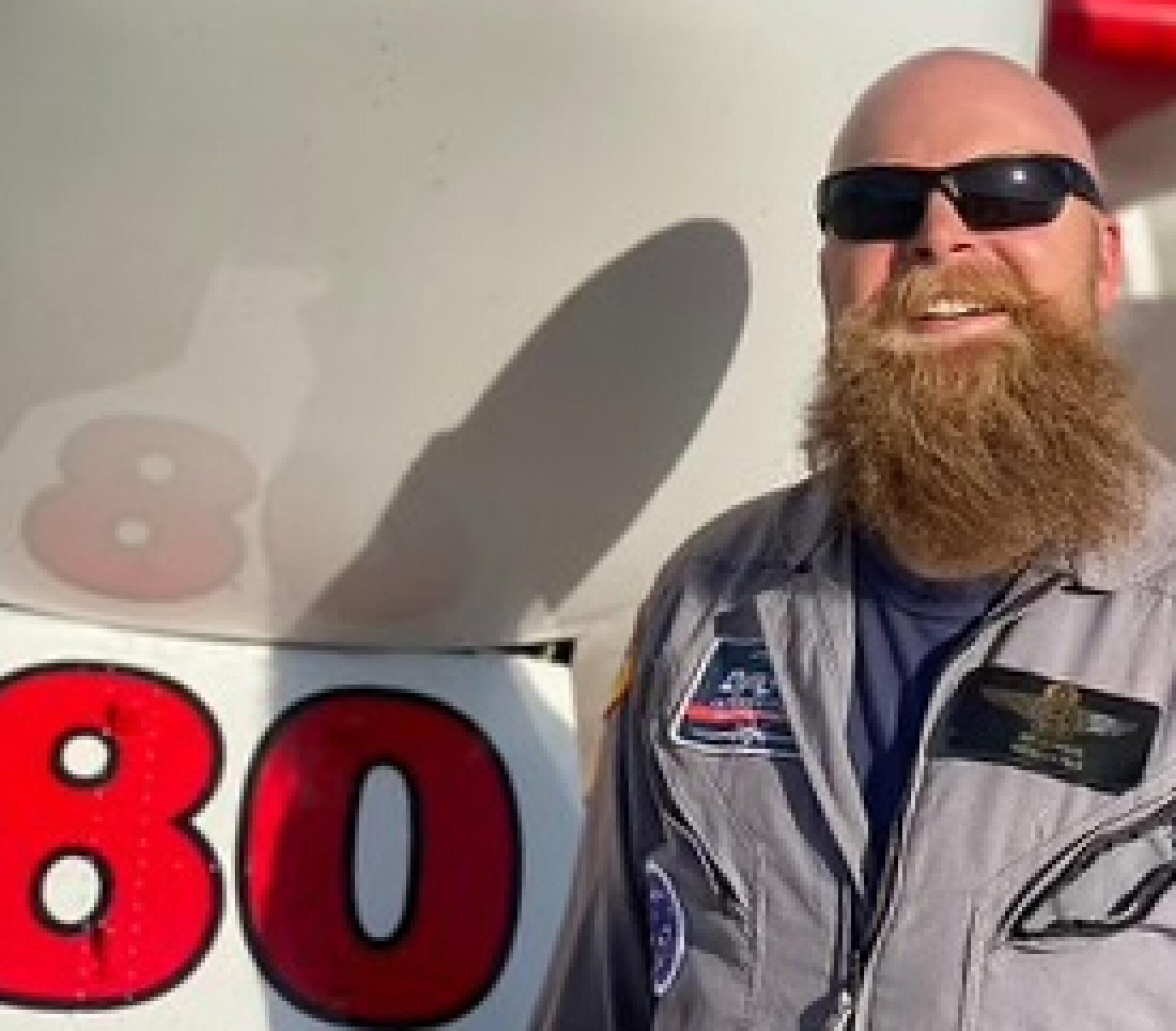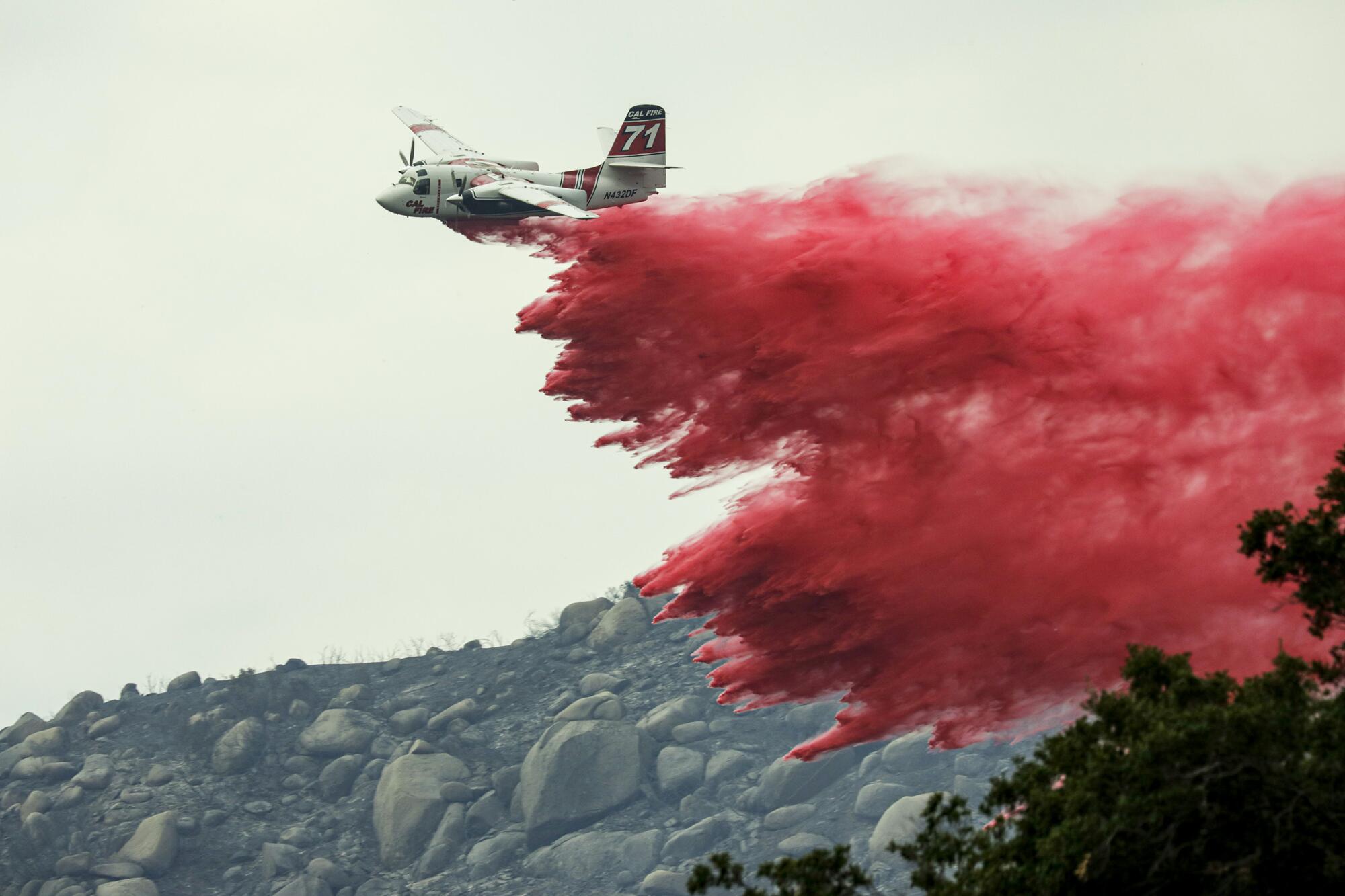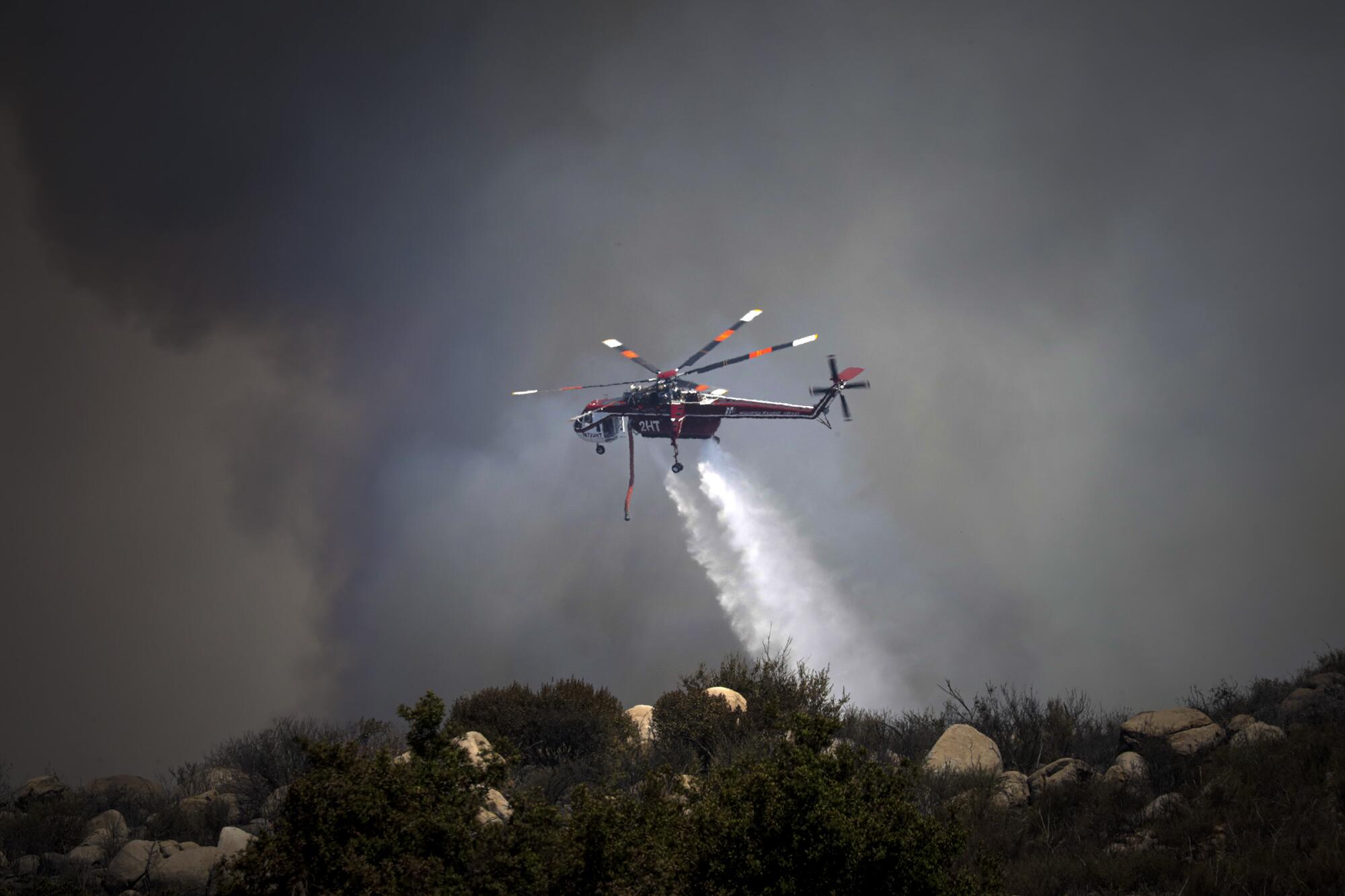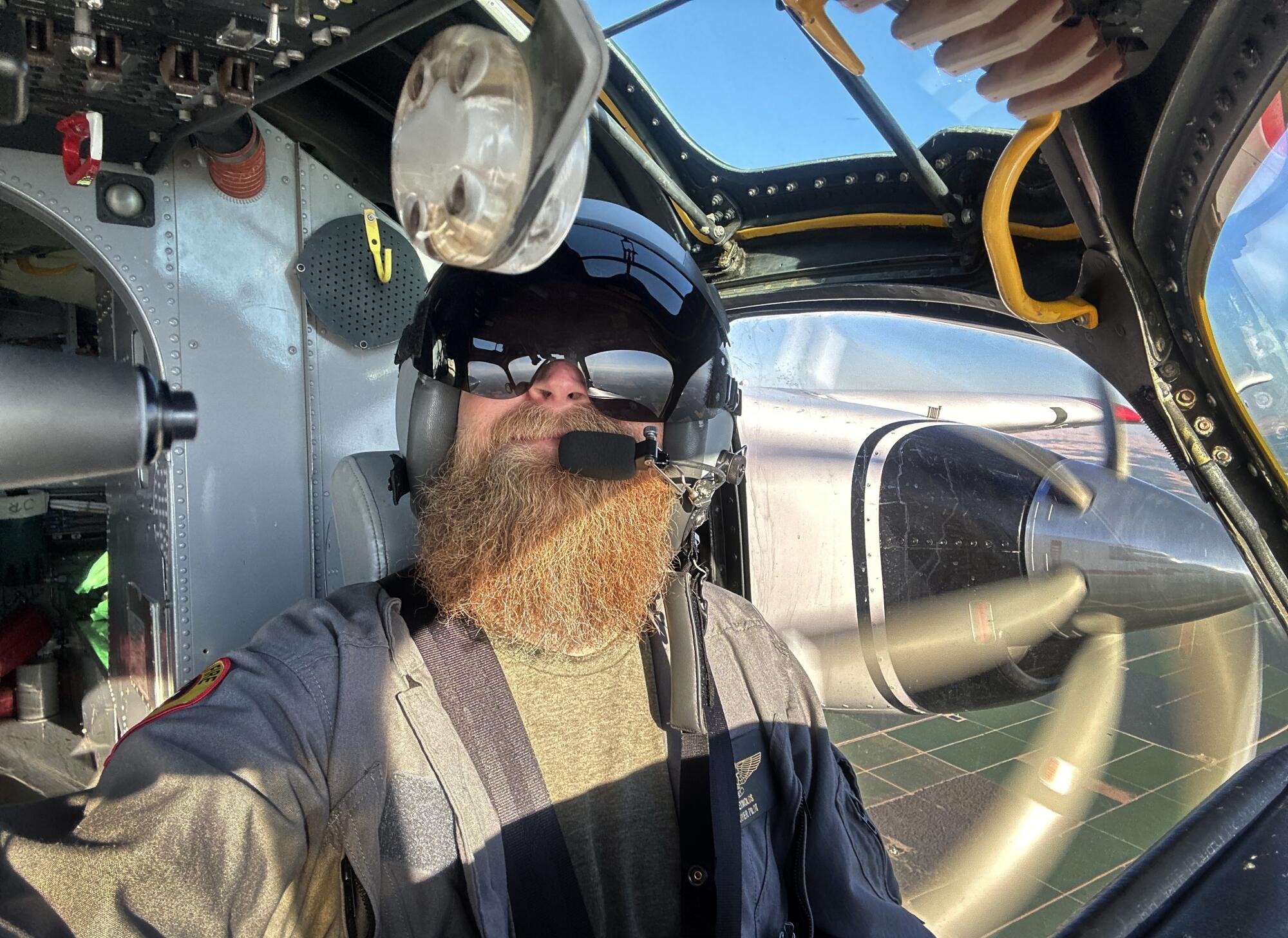
Diving toward a burning hillside in his first season flying an air tanker for the California Department of Forestry and Fire Protection, Jeff Reynolds realized he was doing just about everything his early flight instructors warned him not to.
With the airplane’s hollow wings full of fuel and the belly full of fire retardant, he was “flying heavy” in hot, thin air. He was also going low and slow, simultaneously reducing the plane’s maneuverability while giving himself a razor-thin margin for error. And he was deliberately diving into smoke so thick he couldn’t see other aircraft or the terrain around him.
It all added up to “a disaster waiting to happen,” Reynolds recalled in a recent interview.
He was a little off target, so a controller told him to go around and try again. Still burdened with about 1,000 gallons of fire retardant, he shoved the throttles forward to squeeze more power from the howling engines and pulled back on the controls to start an agonizingly slow climb.

That’s when he noticed an odd white shape at eye level out the windshield. It was a utility truck — at the same altitude as him — crawling along a hillside he did not expect to be there. The hair stood up on his forearms.
It was beginner’s luck, not skill, that saved him from slamming into that mountain, Reynolds said. The hillside was off to the right and he was already turning left. But that moment of shock still haunts him years later.
“I’ll hold onto that memory forever and ever,” Reynolds said with a shiver in his voice.
We’ve all seen the dramatic news video: a plane swooping out of the sky and dropping a long line of bright red retardant on the leading edge of a fire racing up a hillside, or a helicopter, with a giant bucket of water dangling underneath, dousing the vegetation around someone’s house to save it from flames.
It’s hard not to gasp in awe at the power and capability of those machines. And, in a state where wildfires of previously unimaginable size and destructive force have become the norm, it’s hard to imagine anyone more indispensable than those pilots.
An S-2 air tanker flying over the Park fire. (Jeff Newby)
But Reynolds is among a small, and shrinking, fraternity of experienced aviators willing to eschew the relative luxury and high pay offered by large passenger airlines or private jet companies — think crisp white shirts and first-class lounges — for the hot, dirty, dangerous work of aerial firefighting.
They wash their own planes and pump their own gas. They wear dumpy overalls. Most get paid a fraction of what captains at United and American airlines make, and they die at an alarming rate.
Since 2020, there have been at least 14 fatal crashes of airplanes and helicopters fighting fires in the U.S, killing at least 25 pilots and crew members, according to a Times review of data maintained by the National Transportation Safety Board.
Planes have slammed into burning mountainsides. A helicopter crashed after the hose it used to suck water from a lake broke free and got tangled in the rotor blades.
In one memorable case, a pilot lost his bearings after a plane above and in front of him dumped its load of retardant on his windshield, cloaking his view. He dumped his own retardant to become more maneuverable, but that just made him lighter and faster. He climbed straight into the plane in front of him, killing both pilots.
An official tally of the number of aerial firefighters working in the U.S. is hard to come by, but industry veterans guess there are a few hundred working directly for government agencies and perhaps twice as many working for private contractors.
For perspective, not one of the nation’s more than 100,000 scheduled passenger airline pilots has been killed in an accident since 2020.
Work schedules for aerial firefighters vary depending on the employer. Some contractors work year-round, traveling the globe and flying wherever the land is burning and someone is willing to pay for their services.

Others work only during “fire season,” which in the Western U.S. used to be confined to the hottest, driest summer months but has been expanding in length and intensity in recent years. And it’s not a Monday-to-Friday job: Most pilots work something close to 10 days in a row followed by five days off.
Aerial firefighting is “the closest thing to combat flying you’ll find in civilian life,” said Montie Vanlandingham, a recently retired chief pilot for the Sacramento Metropolitan Fire District who spent more than 20 years flying Army helicopters, including tours in Afghanistan.
But with the country at peace, the steady pipeline of military pilots with thousands of hours at the controls in high-stress situations is slowing. And it’s not just the number of pilots that’s shrinking; it’s the number of hours pilots in the military are able to accumulate.
Dan Anderson, an instructor pilot for Cal Fire, spent decades in the Army and flew medevac helicopters in Iraq and Afghanistan. On a combat tour, he could rack up 500 flight hours in a year, Anderson said. Today, many military pilots are lucky to get 80 hours a year, he said, which makes a huge difference in their comfort and familiarity with the aircraft.
Replacing those precious hours with private training can be done, but it’s cripplingly expensive.
It can easily cost a civilian student $100,000 to get the bare minimum of time at the controls of an airplane they’ll need for commercial certification, which is what’s required for even the humblest entry-level jobs. In a helicopter, it can be twice as expensive.
Typical first jobs include teaching other students the basics, like simple take-offs and landings, or flying back and forth across vast rural landscapes surveying power lines and oil pipelines.
The pay is terrible, the locations are often remote, and the work is monotonous. And it can take years to build up the thousands of hours of experience required to even be considered for a job such as aerial firefighting.
View inside a CalFire C-130 tanker during a training run. (Scott Robinson)
“How do you get that spark in someone,” Anderson asked, to endure the grueling apprenticeship for a job that comes with unpredictable hours and unavoidable risks? It isn’t easy. “They have to really want it. It has to be something that burns in them.”
For Bryce Mitchell, a helicopter pilot for the Sacramento Metropolitan Fire District, that spark began when, as a teenager, he joined the department’s volunteer youth program. His first boss, Vanlandingham, remembers him as a “geeky kid” standing with a hose in his hand, gaping in wonder as he washed the helicopters.
Mitchell laughed at the description, but didn’t dispute it. “It’s funny, I knew right then I wanted to go fly.”
So, when he got hired by the department as an entry-level firefighter, he didn’t spend his first paychecks on a fancy new truck, or “brodozer,” as so many of his contemporaries did. He lived in a van and spent every penny he had on a small $60,000 training helicopter.
He hired a flight instructor to teach him to fly it, and once he accumulated enough hours to earn his own instructor’s certificate, he started a flying school.
“For quite some time, we were the cheapest flight school on the planet,” he said with a laugh, recalling the sheer audacity of it. When he wasn’t teaching, he’d take the little R22 up into canyons near his home in Auburn and practice the tight maneuvers he’d have to execute when (not if) he got a job as an aerial firefighter.

On a really hot day, hovering over a riverbed in a broiling canyon, the underpowered machine acted a lot like a bigger, more powerful helicopter at higher elevations over a raging wildfire. It was surprisingly good practice, Mitchell said.
In addition to flying in his free time, Mitchell spent years working his way up the pecking order in the department’s aerial operations. He began as a rescuer, the guy who dangles beneath the helicopter on a cable to save injured — or just terrified — hikers and skiers stuck in spaces that are too steep and sketchy for the helicopter to land.
Then, he became the crew chief, directing the rescuers and handling navigation and communications while the pilot flew. There can be 10 radio channels chattering in your headset at once, Mitchell said, and all of it is critical information: reports from other aircraft on the scene, firefighters on the ground, air traffic controllers directing the coordinated chaos.
“You have to be very, very focused. You’re using all of your bandwidth in that position,” Mitchell said.
He has arranged his whole life around aviation. On his days off, he builds experimental planes or goes BASE jumping with friends. But he cringes when anyone suggests he’s an adrenaline junkie.
He regards all flying as “ultra-condensed meditation.” When you’re so focused on the task at hand, whether it’s diving in a helicopter at roaring flames or carving a perfect line in a wingsuit, nothing else matters.
“The mortgage doesn’t matter. Your interpersonal relationships don’t matter. Your brain is focused in a way that is wildly healthy for you,” Mitchell said.
And every now and then you save someone’s life, which makes it all worthwhile, he said.
Jonathan Rohloff is still reeling from the horror of watching his 20-year-old daughter slide to her death off Yosemite’s Half Dome. He said his request for more safeguards on the century-old climbing cables that lead to the summit has met with “deafening” silence from park officials.
For Reynolds, the spark ignited when he was growing up in Rancho Cucamonga, watching planes drop fire retardant in the San Gabriel Mountains.
When he started flight school after a brief career in sales, his first instructor asked him about his professional aspirations. Students almost always say the same thing: They want to become airline pilots and get paid huge salaries to travel the world in sleek jets.
So when Reynolds confessed he wanted to fly grimy old air tankers, his instructor didn’t know how to react. The goal must have seemed inconceivably “blue collar,” Reynolds joked.
One of his first flying jobs was towing advertising banners, first in Florida and then in Southern California out of the Compton airport. “I was back in sales,” Reynolds said. “I sold sunscreen, vodka, condoms … everything.”
One of his most memorable assignments was towing a banner for the Los Angeles Kings over downtown after the team won the Stanley Cup. He wasn’t expecting all of the news helicopters hovering over the parade.
It was a white-knuckle test of his airmanship, Reynolds recalled. “I literally had to weave in and out of them ... like pylons.”

It took seven years and 3,000 hours of flight time for Reynolds to get his first break in aerial firefighting. In 2016, he was working for a private charter company, piloting the equivalent of an airborne limousine. He had dropped some clients off at the Monterey airport when he noticed a woman washing ash and dead bugs off the front of her plane, telltale signs she had been flying low and slow over a wildfire.
He swooned and struck up a conversation. She was, in fact, flying “air attack,” essentially acting as the airborne air traffic controller over a nearby inferno.
They exchanged information, and soon he too was flying air attack for a small private contractor all over the Western United States. A couple of years later, he got his dream job flying a Vietnam War-era air tanker and diving directly at the flames.
Today, when he explains to other pilots what he does, he says they get an odd look on their faces and ask if it’s a “summer gig” or something he’s doing while waiting for a chance with a major airline. “No, this is actually my career,” he explains.
He’ll never earn the big money flying wide-body planes to Tokyo, or ferrying celebrities to the Cannes Film Festival on luxury private jets. But he does get to save lives and homes.
“It’s a mission,” he said, “and a labor of love.”












